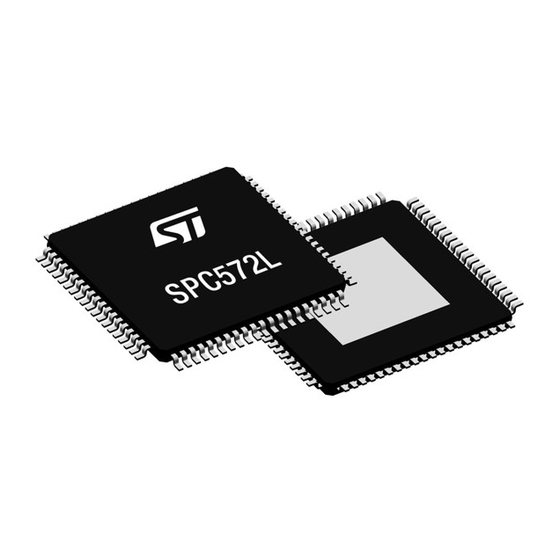
STMicroelectronics SPC572L series Manuals
Manuals and User Guides for STMicroelectronics SPC572L series. We have 1 STMicroelectronics SPC572L series manual available for free PDF download: Reference Manual
STMicroelectronics SPC572L series Reference Manual (2058 pages)
Brand: STMicroelectronics
|
Category: Microcontrollers
|
Size: 38 MB
Table of Contents
-
-
Audience91
-
Overview91
-
Preface91
-
Introduction93
-
Feature List96
-
Packaging97
-
Overlay SRAM100
-
Overview100
-
Sram100
-
System SRAM100
-
Package Pinouts105
-
Pin Descriptions105
-
System Pins106
-
LVDS Pins107
-
Generic Pins108
-
Memory Map109
-
Core Module117
-
Introduction117
-
System Modules122
-
Analog Modules154
-
Timers155
-
FEC Interface159
-
CAN Nodes160
-
LFAST and SIPI160
-
Safety Modules173
-
Security Modules178
-
Introduction185
-
Reset and Boot185
-
Boot Header186
-
Reset Sequence187
-
IDLE Phase192
-
Module193
-
DCF Clients205
-
Introduction205
-
DCF Records206
-
DCF Client Table209
-
DCF Client List210
-
Overview218
-
Power Management218
-
Device Trimming225
-
Power Sequence229
-
Basic Security237
-
Security237
-
-
Debug over CAN254
-
Nexus Aurora255
-
E200Z2 Nexus 3258
-
Nexus Clients258
-
Register Model260
-
Exceptions266
-
-
Introduction283
-
Overview283
-
Features285
-
Memory Map286
-
General304
-
Pad Control304
-
Features309
-
Introduction309
-
Arbitration316
-
Features318
-
Introduction318
-
Access Support324
-
Block Diagram325
-
Overview325
-
Features327
-
Memory Map327
-
Introduction345
-
Timing Diagrams345
-
32 Interface355
-
Block Diagram357
-
Introduction357
-
Features359
-
Memory Map360
-
-
Introduction383
-
-
Wait Mode385
-
DMA Transfer441
-
Channel Linking446
-
-
Features451
-
-
Clocking461
-
MC_CGM Registers463
-
JTAG Frequencies464
-
Clock Sources465
-
LFAST Clocking470
-
Clock Monitoring474
-
PLL0 Monitor476
-
Loss of Lock485
-
Signals487
-
-
Features497
-
-
Tion533
-
Tion534
-
Censorship581
-
-
Features593
-
-
Read Mode631
-
Modify Mode633
-
-
Features684
-
-
-
Introduction756
-
-
Abort Conversion761
-
Power down Mode766
-
Scriptions797
-
-
Features806
-
-
Integrator836
-
-
Features860
-
-
Interrupts867
-
-
Overview871
-
-
-
Features875
-
-
Event in (EVTI)877
-
Fetch Trace957
-
Watchpoint Trace959
-
-
Features999
-
-
Block Diagram1000
-
Dual Clock Sources1001
-
Message RAM1046
-
Timestamp Generation1062
-
Timeout Counter1063
-
Dedicated Rx Buffers1067
-
Debug on CAN Support1068
-
Tx Handling1069
-
CAN RAM Arbiter1086
-
ECC Controller1088
-
Introduction1092
-
SIPI Block Diagram1094
-
Standard Features1095
-
Transfer Types1100
-
Read Transfer1101
-
ID Request Response1106
-
Module Disable (MD)1115
-
Acknowledge Error1116
-
-
Features1135
-
-
DSPI Configurations1136
-
Modes of Operation1138
-
Transfer Formats1193
-
Delay Settings1217
-
-
Features1225
-
-
Line Receiver (LR)1257
-
Transmit Controller1265
-
CTS Mode Support1269
-
Frames Supported1270
-
Interrupts1283
-
Packet Memory1285
-
Resets1286
-
Slow Speed Clock1287
-
Rx Controller Clocks1290
-
Tx Controller Clocks1291
-
Introduction1293
-
Features1296
-
Interface Options1297
-
Buffer Descriptors1340
-
Table 784. MII Mode1347
-
FEC Frame Reception1349
-
Hash Algorithm1352
-
RMII Echo1357
-
Introduction1359
-
Features1360
-
-
Modes of Operation1361
-
Block Diagram1362
-
Design Overview1363
-
DMA Read Logic1398
-
Overflow Behavior1403
-
Receiver Diagnostics1405
-
Time Stamp Logic1407
-
Bus Idle Diagnostic1408
-
Introduction1411
-
Main Features1413
-
UART Mode Features1414
-
-
Figure 806. Frames1415
-
Linflexd Features1416
-
Timer1432
-
UART Mode1433
-
DMA Interface1438
-
-
Register Description1458
-
Register Map1494
-
Master Node1497
-
Slave Node1498
-
Extended Frames1503
-
UART Mode1504
-
Features1509
-
Field Descriptions1522
-
Field Descriptions1524
-
Destructive' Resets1539
-
Functional' Resets1540
-
Flow of Control1545
-
Resources1559
-
-
Features1561
-
-
ECC Error Monitoring1567
-
BAF Configuration1568
-
Analog PMC Interface1591
-
-
Features1599
-
-
Memory Map1601
-
Register Description1604
-
-
Modes Details1630
-
Overview1645
-
Trap Debug Event1653
-
Once Introduction1694
-
Jtag/Once Pins1697
-
-
Introduction1720
-
-
Operating Modes1722
-
-
Introduction1731
-
Features1732
-
Register Description1734
-
-
Boundary Scan1741
-
References1743
-
Introduction1744
-
-
Types of Operation1745
-
TAP.7 Architecture1746
-
Protocols1747
-
Operating Models1749
-
T4 Functions1750
-
Start-Up Options1754
-
TAPC State Machine1756
-
EPU Registers1759
-
EPU Commands1769
-
EPU Operating States1777
-
System and EPU Paths1778
-
Operation1781
-
Escape Sequences1782
-
-
Introduction1796
-
Register Definition1797
-
-
Introduction1803
-
Feature Description1804
-
JTAGM Ready Signal1805
-
Software Interface1807
-
Overview1816
-
Features1818
-
-
SPU Actions1819
-
Operation Mode1820
-
Sequence Formation1858
-
Action Unit1862
-
DTS Register Access1867
-
Example Application1870
-
-
Introduction1873
-
-
Overview1874
-
Operation Modes1888
-
Suppress Mode1891
-
Stall Detection1892
-
Output Arbitration1893
-
Aurora Interface1895
-
Timestamp Function1900
-
-
Introduction1909
-
Feature List1910
-
-
Error Messages1949
-
Program Trace1950
-
BTM Message for Mats1952
-
Data Trace1960
-
DTM Operation1963
-
Block Write Access1970
-
Single Read Access1971
-
Error Handling1972
-
Pin Protocol1975
-
-
Modes of Operation1984
-
Memory Map1985
-
Access Errors1992
-
DCF Clients2006
-
-
Introduction2012
-
Features2013
-
-
Reset Management2021
-
-
Revision History2028
-
-
Advertisement
Advertisement
Related Products
- STMicroelectronics SPEAr300
- STMicroelectronics STM32L151R6
- STMicroelectronics STM32L151CCT6
- STMicroelectronics STM32L151QE
- STMicroelectronics STM32L152RCT6A
- STMicroelectronics STM32F038G6
- STMicroelectronics STM32F042T4, STM32F042C4
- STMicroelectronics STM32F042C4
- STMicroelectronics STM32F031K6
- STMicroelectronics ST72361J4-Auto
